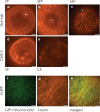Developmentally regulated mitochondrial biogenesis and cell death competence in maize pollen
- PMID: 36316635
- PMCID: PMC9624016
- DOI: 10.1186/s12870-022-03897-y
Developmentally regulated mitochondrial biogenesis and cell death competence in maize pollen
Abstract
Background: Cytoplasmic male sterility (CMS) is a maternally inherited failure to produce functional pollen that most commonly results from expression of novel, chimeric mitochondrial genes. In Zea mays, cytoplasmic male sterility type S (CMS-S) is characterized by the collapse of immature, bi-cellular pollen. Molecular and cellular features of developing CMS-S and normal (N) cytoplasm pollen were compared to determine the role of mitochondria in these differing developmental fates.
Results: Terminal deoxynucleotidyl transferase dUTP nick end labeling revealed both chromatin and nuclear fragmentation in the collapsed CMS-S pollen, demonstrating a programmed cell death (PCD) event sharing morphological features with mitochondria-signaled apoptosis in animals. Maize plants expressing mitochondria-targeted green fluorescent protein (GFP) demonstrated dynamic changes in mitochondrial morphology and association with actin filaments through the course of N-cytoplasm pollen development, whereas mitochondrial targeting of GFP was lost and actin filaments were disorganized in developing CMS-S pollen. Immunoblotting revealed significant developmental regulation of mitochondrial biogenesis in both CMS-S and N mito-types. Nuclear and mitochondrial genome encoded components of the cytochrome respiratory pathway and ATP synthase were of low abundance at the microspore stage, but microspores accumulated abundant nuclear-encoded alternative oxidase (AOX). Cytochrome pathway and ATP synthase components accumulated whereas AOX levels declined during the maturation of N bi-cellular pollen. Increased abundance of cytochrome pathway components and declining AOX also characterized collapsed CMS-S pollen. The accumulation and robust RNA editing of mitochondrial transcripts implicated translational or post-translational control for the developmentally regulated accumulation of mitochondria-encoded proteins in both mito-types.
Conclusions: CMS-S pollen collapse is a PCD event coincident with developmentally programmed mitochondrial events including the accumulation of mitochondrial respiratory proteins and declining protection against mitochondrial generation of reactive oxygen species.
Keywords: Cytoplasmic male sterility; Maize; Mitochondria; Pollen development; Programmed cell death.
© 2022. The Author(s).
Conflict of interest statement
The authors declare no competing interests.
Figures







Similar articles
-
Restorer-of-Fertility Mutations Recovered in Transposon-Active Lines of S Male-Sterile Maize.G3 (Bethesda). 2018 Jan 4;8(1):291-302. doi: 10.1534/g3.117.300304. G3 (Bethesda). 2018. PMID: 29167273 Free PMC article.
-
The chimeric gene atp6c confers cytoplasmic male sterility in maize by impairing the assembly of the mitochondrial ATP synthase complex.Mol Plant. 2022 May 2;15(5):872-886. doi: 10.1016/j.molp.2022.03.002. Epub 2022 Mar 7. Mol Plant. 2022. PMID: 35272047
-
A nuclear restorer-of-fertility mutation disrupts accumulation of mitochondrial ATP synthase subunit alpha in developing pollen of S male-sterile maize.Genetics. 2003 Oct;165(2):771-9. doi: 10.1093/genetics/165.2.771. Genetics. 2003. PMID: 14573487 Free PMC article.
-
The Role of Non-Coding RNAs in Cytoplasmic Male Sterility in Flowering Plants.Int J Mol Sci. 2017 Nov 16;18(11):2429. doi: 10.3390/ijms18112429. Int J Mol Sci. 2017. PMID: 29144434 Free PMC article. Review.
-
Genome barriers between nuclei and mitochondria exemplified by cytoplasmic male sterility.Plant Cell Physiol. 2008 Oct;49(10):1484-94. doi: 10.1093/pcp/pcn102. Epub 2008 Jul 14. Plant Cell Physiol. 2008. PMID: 18625609 Free PMC article. Review.
Cited by
-
Varied chromosome distribution behaviours during meiosis in triploid Chinese chives contribute to the formation of viable pollen.Chromosome Res. 2024 Dec 2;32(4):15. doi: 10.1007/s10577-024-09759-7. Chromosome Res. 2024. PMID: 39617814
-
Transcriptomics reveals a core transcriptional network of K-type cytoplasmic male sterility microspore abortion in wheat (Triticum aestivum L.).BMC Plant Biol. 2023 Dec 6;23(1):618. doi: 10.1186/s12870-023-04611-2. BMC Plant Biol. 2023. PMID: 38057735 Free PMC article.
-
Mutations in nuclear genes encoding mitochondrial ribosome proteins restore pollen fertility in S male-sterile maize.G3 (Bethesda). 2024 Oct 7;14(10):jkae201. doi: 10.1093/g3journal/jkae201. G3 (Bethesda). 2024. PMID: 39163571 Free PMC article.
References
-
- Carlsson J, Leino M. Sohlberg J Sundstrom JF, Glimelius K. Mitochondrial regulation of flower development Mitochondrion. 2008;8:74–86. - PubMed
MeSH terms
Substances
Grants and funding
- IOS-0816782/National Science Foundation
- IOS-0816782/National Science Foundation
- IOS-0816782/National Science Foundation
- IOS-0816782/National Science Foundation
- IOS-0816782/National Science Foundation
- IOS-0816782/National Science Foundation
- IOS-0816782/National Science Foundation
- IOS-0816782/National Science Foundation
- 2005-35301-15/National Institute of Food and Agriculture
- 2005-35301-15/National Institute of Food and Agriculture
- Institute of Food and Agricultural Sciences Undergraduate Research Internship/University of Florida
LinkOut - more resources
Full Text Sources

